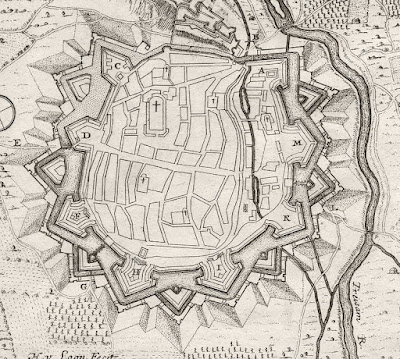
|
|
The remains of the fortress belt near Breisach Gate (circled)
after the dismantling of the city fortifications (©BJ) |
As Lagniappe, he reported on new traces of Vauban's legacy that his institute had recently uncovered while digging into the Bastion St. Louis, on which the Colombischlössle is built.
In an earlier blog, I wrote:
When firearms dominated warfare, Freiburg's old city wall became a joke. During the Thirty Years' War and, particularly during the aggressive French wars in the late 16th and early 18th centuries, öffnete die Artillerie schnell mehrmals eine Bresche in dem maroden Mauerwerk (artillery quickly opened several breaches in the dilapidated masonry).

|
|
Vauban's fortification of Freiburg. North is on the left. The
Breisach Gate is located between K: la Bastion de la Reyne and Bastion M: la Bastion du Roy |

|
|
Another view shows the road to Breisach with a bifurcation to the
north.
The Breisach Gate is the white square within the fortification. |
This is an artist's view of the Breisach Gate, with a bridge over the moat, which was flooded only in the event of a siege. Nearby is the square and the Katzenturm (cat tower), which was used as a prison. The Breisach Gate still exists, while the bastions were built over but are still partly visible topographically today.

|
| ©BJ |

|
| ©BJ |
The situation around the Breisach Gate, as seen from a bird's-eye view in the
19th century. Today's Holzmarkt (wood market) was the Viehmarkt (cattle market). The former Kaiserstraße has become
Kaiser-Joseph-Straße, and the road Dauphinestraße, built
for Marie-Antoinette's visit to Freiburg
in 1770, has become Federal Road 31 into the Black Forest.

|
| ©BJ |
Today, the interior and forecourt of the Breisach Gate are used for gastronomic purposes.
The Bastion St. Louis - a small red dot marked "b" on the above plan -
was recently dug up as part of the redesign of Colombipark.

|
| (©BJ) |
Dr. Jenisch's lectures are always good for a surprise.
**






No comments:
Post a Comment